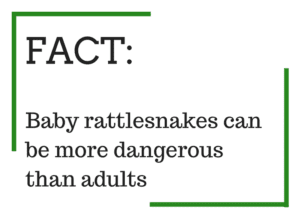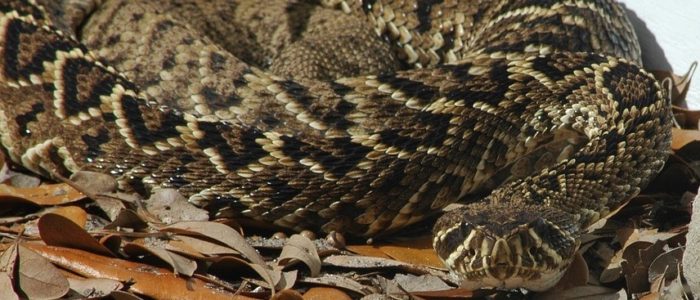Diamonds: precious gems that shine, glitter and….rattle?
We’re not talking about an engagement ring here. We’re talking about the Eastern Diamondback Rattlesnake! According to National Geographic, these snakes are the largest venomous snakes in North America and can be found throughout North Carolina, all the way down to Florida and over to Louisiana. But not to worry! We service those areas.

What does an Eastern Diamondback look like?
These rattlesnakes are distinguishable from other rattlesnakes by the telltale diamond pattern on their backs. The center of the diamond is filled in with dark brown and outlined in creamy white. Another way you can tell if it’s a rattlesnake is by its tail. Figure eight shaped rattles form on a rattlesnake’s tail each time they molt or shed their skin, but rattles get damaged and fall off. So, the myth of counting a rattler’s tail to determine its age has been debunked. Another telltale sign of a rattler is the shape of its head. Pit vipers (the family of snake to which the rattle snake belongs) typically have triangular shaped heads with a divot or “pit” near the eyes. This pit is actually a sensor that allows the snake to sense heat, but more on that later.
Rattlesnake: Pit Viper
As previously stated, Eastern Diamondbacks are classified as pit vipers. Other snakes that live in South Carolina that fall under this category include pigmy rattlesnakes, timber rattlesnakes, copperheads, cottonmouths and water moccasins. Pit vipers have an organ between their eyes and nostrils that senses heat. This allows the snake to hunt more accurately, especially in the dark. Pit vipers like to hunt at night because the air is cooler and heat coming from prey is more obvious. The amount of heat that comes from bigger animals is also a good indication to the snake to get out of dodge.
Pit Viper Venom
Although this scaly reptile may be slightly terrifying, you can take comfort in the fact they do not intentionally hunt humans. That being said, don’t pull a Steve Irwin and make friends with the snake. They are incredibly dangerous and toxic. An eastern diamondback’s venom is a hemotoxin that kills red blood cells. The dying off of red blood cells can cause tissue damage and even shut down organs. However, the southeast (the rattler’s primary habitat) is ripe with antivenin. Prompt treatment puts mortality rate of a bite from this snake below 4%. But you should still expect scarring after an encounter with one of these reptiles, antivenin or not.
For more facts and tips, visit our blog!

